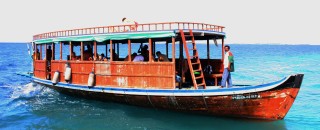
Our dive boat was a traditional wooden "dhoni"
|
Underwater Pages Diving Pages Related Pages Maldives HomeNewsletters Cruising Info |
Diving Maldives
| Island/Atoll | Dive Name | Depths | 2007 |
|---|---|---|---|
| Addu Atoll | Wigg's Reef East | 12-57' (4-18m) | April 07 |
| Wigg's Reef West | 12-44' (4-14m) | April 07 | |
| Bushy East | 20-70' (6-21m) | April 10 | |
| British Loyalty Wreck | 45-100' (17-30m) | April 11 | |
The Maldives, a country of more water than land and dozens of huge atolls, has long been famous for its incredible coral reefs and abundant fish. Unfortunately, the reefs were hit by the effects of the 1998 El Nino ocean warming and much of the hard coral in the central and northern atolls was badly bleached. We were lucky in that we took Ocelot into Addu Atoll, the southern-most atoll of the group, which lies south of the Equator. Here, the bleaching was much less, and the coral is still abundant and colorful.
 Our dive boat was a traditional wooden "dhoni" |
As a tourist/diving destination, the Maldives is a bit odd -- there are many up-scale resorts to choose from, virtually all of which offer diving, but there are essentially no guest houses outside of the capital of Male, and no facilities for independent travelers who wish to self-cater. The official stance is that tourist hard currency is a good thing, but western ideas are not, so the tourists and local population are segregated as much as possible. They're actually pretty up-front about this attitude. Tourists and locals are not encouraged to mingle, and only in Addu Atoll, where the British built several causeways joining all the western islands, is it really possible at all.
 Map of our track & dives in Addu Atoll, Maldives. Click on a dive flag to see that dive. |
There are 2 recompression chambers, located at Bandos and Kuramathi resorts on North Male Atoll and Rasdhoo Atoll, both run by commercial dive outfits. There is a DAN (Divers Alert Network) branch at Bandos. It is a Maldivian law that no dive is to exceed 30 meters (100') in depth or 1 hour in time.
On Addu Atoll we dove with Diverland Gan which in 2007 charged US$40 for single dives with a surcharge of $10/person for use of the dive boat (prices assumed we had our own gear, except tanks and weights). Divers with fewer than 30 dives or for anyone's first dive with the company there was an additional $3 charge, and the addition of another diver master on the trip. They are the only dive outfit on the island (in fact they're at the only resort in the whole atoll) and have over 30 named dive sites. Tank fills (when we dove on our own) were the standard $3-5 per tank.
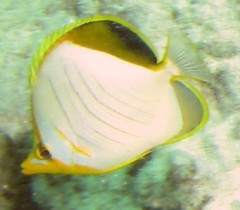 The Yellowhead Butterflyfish is found only in the Indian Ocean |
We used our new image stabilized Canon A710 IS with underwater housing and external flash for the photos. All are credit and copyright Amanda Hacking unless otherwise noted. For fish ID we found a small locally published book Reef Fishes of the Maldives by Dr. R. Charles Anderson to be very helpful, especially with those fish endemic to the area or to the Indian Ocean, and therefore not covered in our bigger field guide specializing in fish of the tropical Pacific (Reef Fish Identification Tropical Pacific by Allen, Steen, Humann, Deloach). The Pacific? Well, it's not as strange as it sounds -- the Indo-Pacific is all one bio-region when it comes to ocean life, but there are some fish and other reef animals found only in the Indian Ocean so we needed another guidebook.
The word "atoll" comes originally from the Divehi (Maldivian language) word "atolu". They should know -- their whole country is atolls! They also have their own vocabulary for undersea structures and passes. In Devehi "kandu" means pass. What we call "bommies" - underwater mounds - they divide into two types: a "thila" is a coral bommie that rises from the ocean floor to within about 15' (5m) of the surface, while a "giri" rises to just below the water surface, and may be too shallow to swim or snorkel over.
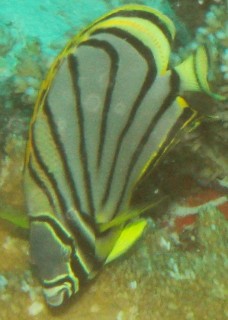 The elegant Meyer's Butterflyfish |
(Amanda) We tied Tomcat(our dinghy) and Estrela's dinghy to the channel pylon and splashed into 12 ft. then swam east along the shore of Gan Island. The water was very warm (about 30C), with a cool thermocline about 5m below the surface. The warm surface water wasn't as clear as deeper down. There wasn't much to see but sand at first, but then found some large coral bommies in 30 to 60 feet. Saw a big Black-blotched Porcupinefish and lots of others, mostly small, but abundant around the coral. Some big groupers were lurking just out of photo range, of course. We were only going for half a tank so turned around rather soon. Somehow, I'm not sure how, we found more coral on the way back to the dinghy.
 A Spot Tail Sandperch rests on the sand |
(Sue) Lady's dive! We did this dive with Kyle Hopkins, the mom on Estrela, cruising friends anchored next to us. Kyle is a new diver so it was a real confidence booster for her to have a mellow time underwater, moving slowly while I took photos of fish and coral. Being inside the lagoon, there was virtually no current, and the water was very comfortable (over 80 degrees F). We had no agenda, no where we had to go -- just along the coast and back. The guests at Equator Village Resort call this the "Home Reef", and while it's not spectacular, it did have lots of fish! Some of our favorites here (and pretty common) were the Meyer's Butterflyfish with their black patterns sweeping along the body, the Indian Dascyllus with their little squared-off bodies and blue fins, and the Regal Angelfish dressed in bright blue and yellow. This site is supposed to be good for night diving, as well, which we didn't get a chance to do.
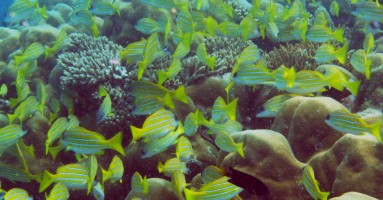 A school of Blue Stripe Snappers cover a "thila" |
(Sue) This was a second dive from the same dinghy location, but this time with Doug, not Kyle, from Estrela. We splashed into about 12 ft, then followed the sandy slope down and out the channel. We circled a big bommie (thila) that was home and hunting grounds to a hefty Humphead Wrasse and several 0.5 meter groupers. Schools of Bluestripe Snapper Lutajanus kasmira congregated there, and large, terminal phase parrotfish darted around feeding on the algae on the coral. Swimming west we saw many patches of live coral with good coloration -- brown, green, and blue. We passed an inquisitive moray and a young hawksbill turtle. These beautiful, slow swimming turtles are fairly common among the reefs of Addu. You can just hear them drawling, "Hey dude!" like the turtles in "Finding Nemo."
(Amanda) I think this was the first time I saw a moray eel in the Indian Ocean. They're just not as abundant as in the Pacific. He was happily sticking out of his hole, mouth opening and closing as he tasted the water and tried to attract little fish into his lair. I'm not a little fish, so I stayed well clear. They look extremely aggressive, moving their head like that. We also saw a lionfish and a couple big trevally, plus a nice crinoid. I had the camera for this whole dive, so I was having lots of fun - although I swear the darn fish 'hear' when I'm thinking how I'm going to get a great photo, and all scatter. This area was much more alive than the other side of the harbor pass, AKA Wigg's Reef East (though why it's like that I do not know.) We also didn't have to swim as far to find bommies. It's a good snorkel site, actually, but when taking photos it's always easier to be scuba diving so you can get up close and personal hopefully without scaring the fish to bits in the process.
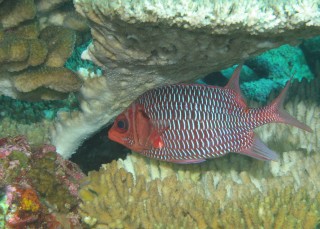 Violet Squirrelfish under plate coral |
(Sue) We did this afternoon dive with Diverland Gan along with cruising friends (and new diver) Kyle and Doug Hopkins from Estrela. Having sailed outside this atoll and through the pass we were all very aware of how incredibly strong the currents could run, so we did not want to do a drift dive -- the usual morning dive with the company. We and 12 others gathered on the traditional "dhoni" boat on the concrete customs pier near the Equator Village Resort on Gan. These boats are deep hulled, and wooden, with high bows and a blunt stern. The helmsman stands at the stern to steer with a huge long wooden rudder. There was shade in the center of the boat (where the tanks were neatly stowed) or you could climb a ladder on the foredeck to sit on the top of the cabin for sunshine and a great view. It was a half an hour ride north across the lagoon to Bushy Islands (seen on nautical charts as Fathikedeheragandu. What a name!).
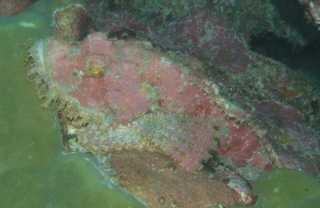 A Tassled Scorpionfish camouflaged on the coral |
We dove on the north side of the island, towards the east and the Maa Kandu (Maa Pass). We splashed on the top of the wall, and descended to about 50' (17m) where the sponges were colorful among the plentiful hard corals. We headed east, with right hand on the wall. Amanda had the camera and got some lovely shots. It was worthwhile to be on a commercial dive as on our own we would probably never have seen the fantastic pink Tassled Scorpionfish that lay camouflaged so perfectly against a pink coral. Our guide, Annie, knew right where to look for it!
(Amanda) This was a nice simple dive, though the current got going quite a bit when we came around the corner. The wall dropped off into the Deep Blue, but we stayed at about 50ft. Or tried. I had the camera, and as usual was frequently below everyone else, chasing fish. The reef was beautiful, and there were lots of little fish. A turtle swam past in the distance, it looked like a big one. The Tassled Scorpionfish was awesome. Annie pointed it out, which is good because it just looked like a lump of coral. She says there are sometimes two on that reef. I guess that's one of the perks of being a divemaster - you get to really KNOW a reef and the fish on it. Surprising she hadn't named them yet...
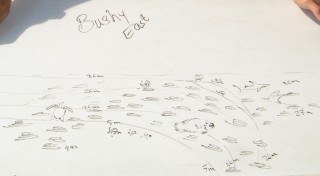 Hand-drawn profile of the Bushy east dive site |
We went a bit shallower and turned around when the current got strong. There were lots of nesting Titan Triggerfish, which we avoided, and many Bignose Unicornfish which like to stay JUST out of camera range. It was mostly plate coral, but quite nice. Supposedly there are ribbon eels on this reef but we didn't see any.
(Jon) This was an easy get-back-into-it dive as it had been several months since I last dove. The half hour ride out to the dive-site was a interesting as the boat was pretty rustic. They had to hand-crank the engine to start it, the rudder vibrated alarmingly and was only held on with rope, and the tiller was badly cracked and had obviously seen better days. Needless to say, there was no bathroom or other amenities on board. An "ethnic experience"...
The corals on the dive were interesting but I would not class them as fantastic. Strangely, there weren't as many fish as I'd expected. Possibly this was because we were sort of on the outside of the reef. While we were fairly protected, Addu Atoll has an indent at the north end, and Bushy Reef is in that indent, so there was nothing between us and the open ocean. Still, those sorts of areas are usually teeming with fish (it's where we catch most of our fish) so I was surprised not to see very many. Luckily, Annie, our dive-master, knew were some rare species tended to hang out and she showed us some fish we would never have found by ourselves.
After the dive, they handed out slices of fresh coconut meat, which was unusual but actually very nice. The rich meat counteracted the saltwater nicely. We've since taken to doing that ourselves when the opportunity presents itself.
On the way back, I sat on top of the boat's sunroof and talked with Annie. She told interesting stories of how the Muslim locals are told us westerners are all immoral, yet many privately drink alcohol, which their religion forbids. The Maldivian resort workers often have mistresses (second wives being too expensive) and many are looking for western women to sleep with at the resorts. Maldivian mistresses on the best islands can apparently be had for the price of a motor-scooter and a cell-phone...
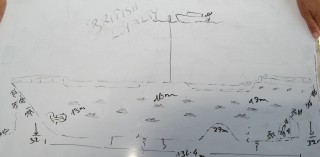 Annie's sketch of the British Loyalty Wreck dive |
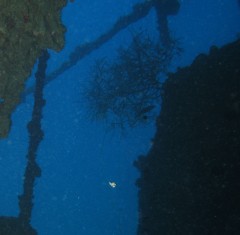 Bushy Black Coral inside the wreck |
(Jon) The British Loyalty is a World War II era tanker with a rather checkered history. She was torpedoed several times and always patched up, but I got the impression that she spent more time being repaired than actually delivering fuel. Soon after the war ended she was considered uneconomic to run and scuttled. She lies on her right side in about 100' (30m) of water with her bows pointing north. She's got a huge hole in her bottom where the scuttling charge went off, but much of the rest of her is still identifiable. Even her anchor chains are still attached. In fact, they forgot to drain all her oil when they scuttled her, and some continues to leak out through rust-holes even today. Since she's lying on her side, things that fall off her deck tend to end up on the sea floor.
The British Loyalty is difficult to find as the wreck is not buoyed (although we noticed that it shows up on our navigational charts!). The local dive shop wants to hide it from local divers, who might want to scavenge parts, in order to preserve it as much as possible. Usually the wreck is hidden, as nearby dredging operations tend to keep the normal visibility low enough to hide even the top of the wreck from the surface. However, on the day we went, we could see the wreck clearly from the surface, and the visibility as we went down was so good that we could see much of the wreck laid out below us. Pretty awesome! I explored all along the deck (which is vertical) and eventually came back to the group just as we all went into the hull and through the hole that was blasted in the bottom when they scuttled her. The propeller had the interesting narrow blades common in older ships, and one of the 4 blades had been knocked off somewhere along the line.
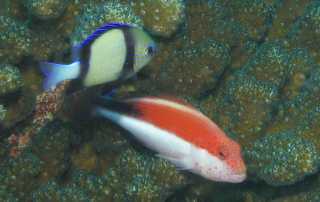 Lovely Indian Dascyllus & Freckled Hawkfish |
(Sue) Amanda took the camera on this, probably our best, wreck dive to date. We went by "dhoni" boat with Diverland Gan out to the wreck along with fellow cruisers Kyle and Doug Hopkins. The wreck lies inside the Addu Atoll lagoon, in still waters. We had fantastic visibility which was lucky, actually, as the visibility can be pretty poor here due to land reclamation projects nearby. As on our Bushy East dive, Swiss Annie was our personal dive guide. We watched from the surface as she descended to 16m to tie on the floating buoy to mark our position for the dive boat. We could clearly see much of the 136m long wreck where it lay on its starboard side in 30m of water. We began our dive about mid-ship near the port railing. On the upturned hull small clusters of healthy new coral were taking hold, giving the appearance of a bright garden with green bubble coral, yellow acropora finger corals, and blue-tipped acroporas. Anemones and huge leather corals made playgrounds for the multitudes of Indian Dascyllus, Yellowtail Anthias, and the occasional solitary Freckled Hawkfish. Orange and red Coral Groupers, with their bright blue spots, flicked in and out of the wreckage.
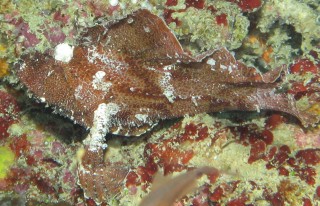 A Leaffish, camouflaged on the wreckage |
(Amanda) Such an awesome dive! We could actually see the wreck from the surface, and I got a picture of Annie when she was 50ft (15m) below us, waiting. When we got down to her level, Annie led us towards the bow of the wreck. The side of the hull was just like a coral garden, nice little patches here and there. Annie carried a dive light, and spotlighted a nudibranch and a Leaf-fish for us. We swam to the bow, then back along the way we'd come, but deeper now, to where we found a huge propeller (not from the British Loyalty) in the sand. This was the marker for an opening into the hull -- and one by one we swam down and through the bowels of the ship, emerging on the far side. It wasn't far, or long, or very dark, but it was a bit nerve-tingling. We would never have attempted it without our guide! From the gaping hole we swam aft to find the huge propeller and then to the aft deck of the wreck. The water at the stern and near the hole was much more silty than elsewhere, and it was nice to come up to a moderate depth and get the good clarity again. For our safety-stop we just drifted, using the inflated sausage as a marker for the dive boat on the surface. Later we were told that was the best visibility they'd had there for ages. I can believe it. Surely that great viz wasn't on our other dives.
Top Level: Home | Destinations | Cruising Info | Underwater | Boat Guests | Ocelot | Sue | Jon | Amanda | Chris | Site Map | Make a Comment
|
If our information is useful, you can help by making a donation |
Copyright © 2000‑ Contact: Jon and Sue Hacking -- HackingFamily.com, svOcelot.com. All rights reserved.